(VOVworld) – For centuries, the Vietnamese people have had a folk saying: “Móng Cái porcelain, Hương Canh jars”, to compliment two of the best-quality terracotta brands in the northern region. Ceramic products made by Hương Canh artisans are famous for their outstanding durability, and their ability to waterproof and block out light, which help fully preserve the food inside for years.
Hương Canh is an old ceramic and pottery craft village located in Bình Xuyên district in Vĩnh Phúc province. The village is known for its rustic line of products, including pans, pots and cups, which are very strong and practically made to serve the essentials needs of rural life. According to the elderly, Hương Canh villagers might have been making ceramic products for more than 300 years. However, where the craftsmanship actually came from is still a matter for debate.
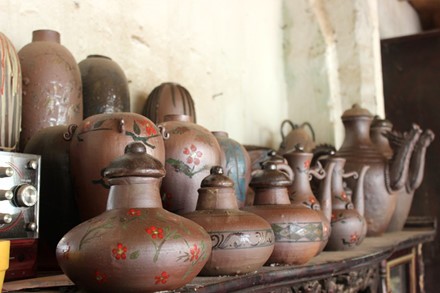 |
| Hương Canh pottery products are made from the typical local clay of green color, which turns into dark reddish brown under high temperatures.(Photo: laodong.com.vn) |
Trần Ngọc Lâm, a Hương Canh citizen who has spent several years tracing its history, offered his view: "The pottery craft in Hương Canh actually originated from Thủ Hà crafting village in Bắc Giang province. Every year during the dry season, pottery traders went upstream on the Cầu river, which also runs through Vinh Phúc province, to sell their products. They usually took a rest in our riverside village and eventually passed on the craftsmanship skills to the local people. Now you can still find many ceramic or terracotta pieces alongside the riverbanks.”
Hương Canh pottery products are made from the typical local clay, taken from a depth of 8 meters below the ground. The clay soil has a special green color which turns into dark reddish brown under high temperatures. Yet, the most distinguishing feature of Hương Canh’s green clay lies in its ability to shrink at high heat.
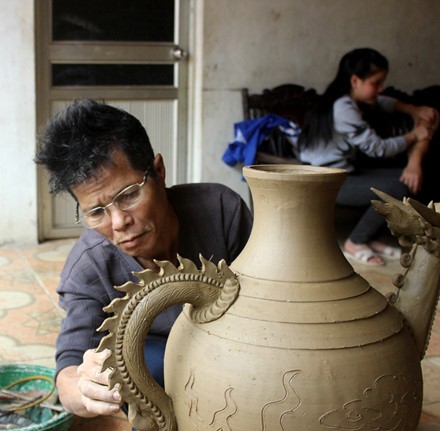 |
Artisan Trần Văn Hải is the fourth generation in his family to produce pottery products and the only artisan who knows how to build a hand-built kiln in his village. (Photo: laodong.com.vn)
|
Artisan Trần Văn Hải, 62 years old, is the owner of Hải Ất ceramic company, one of the four remaining families that produce pottery products in Hương Canh village. Hải learnt how to make terracotta goods from his parents at the young age but it took him decades to master the unique structure of Hương Canh soil. He said:“Inside the kiln, Hương Canh clay can shrink up to 26% while it’s only up to 13% in all other villages in Vietnam. We call this typical characteristic of our soil the ‘fat element’. Because of the chance that raw products shrink is so high, it’s very hard for us to calculate the design and the size of the final products. However, because the ‘fat element’ will vanish under high heat, the clay actually gets tighter and helps our jars and pots to remain more durable and harder than other ceramic products.”
Thái Nhật Minh is a sculptor who has experienced arts with a diverse range of materials, including the green clay of Hương Canh. He said the soil here is one of the most difficult materials he has worked with so far in his 10-year career:“The green raw clay will turn dark after being furnaced and you cannot apply any glaze to it. Without the overall glaze, Hương Canh products are very limited in creation and innovation. And you never know how the products look like before coming out of the kiln. A big pot can shrink by as much as half its size. However, the unique characteristic of Hương Canh make its products much more durable and can be used for many, many years, even for centuries.”
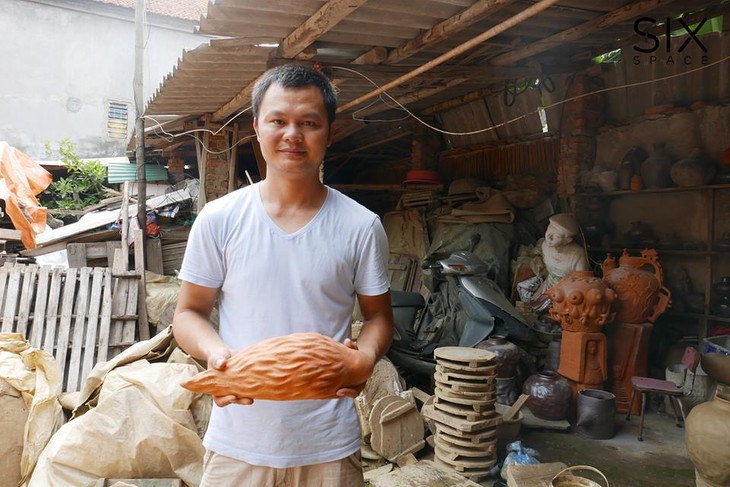 |
Sculptor Thái Nhật Minh is currently experimenting his works with Hương Canh clay material. (Photo: Six Space)
|
Trần Ngọc Lâm said it is the rustic color and rough surface that creates the original and authentic beauty of the crafted products:“Any pottery product with glaze is not made by Hương Canh villagers. Under the heat of up to 1,200 DC, the clay melts and blends together to create a shiny outlook in the final products.”
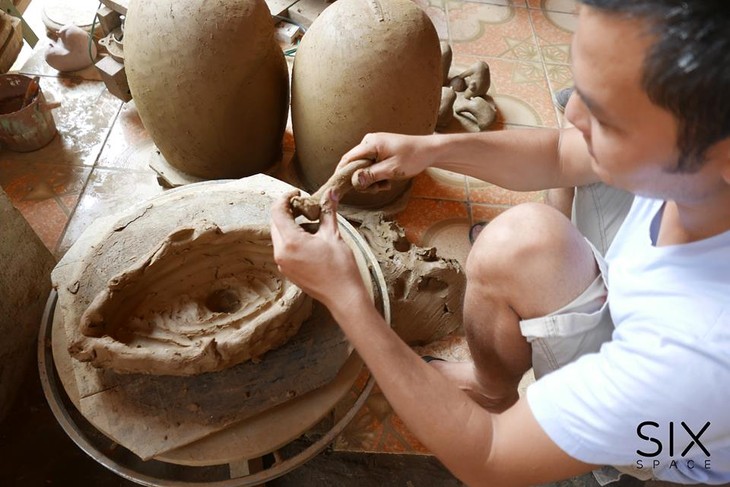 |
The making of a Hương Canh pottery product (Photo: Six Space)
|
To make high-quality products, Hương Canh’s artisans must obey particular technical requirements, especially regarding the kiln and the furnacing. Unlike those in other famous Vietnamese ceramic crafting villages, a typical furnace in Hương Canh can only create a one-way flame and pottery makers actually use of the fans inside the kiln to direct the flame.
According to artisan Trần Văn Hải, controlling the fire is tricky as you can easily burn one side while the other side is still raw. Raising the heat before the right moment can create bubbles on the surface of the pots whereas if you are keep a low heat for even a minute too long, the clay will never be ‘cooked’ thoroughly. He said:“The firing formula must accord to the clay’s characteristics. It took me as long as 36 hours to complete firing a batch of the products, followed by 2 days to cool them down totally. In the first 28 hours, we maintain the temperatures inside the kiln at a steady 500 DC, and raise the temperatures to 850 DC over the next 6 hours and for the last 2 hours the heat must be kept at around 1,200-1,300 DC. But that also depends on the weather; we have different firing methods for different conditions in summer and winter. Hương Canh pottery products may be sold at higher prices but we have to put much more effort into making it.”
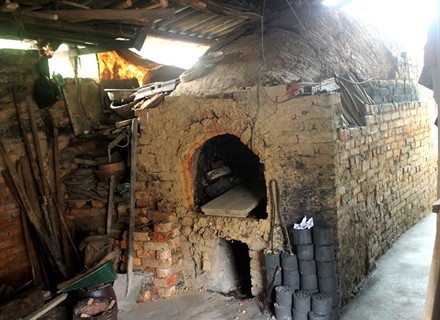 |
| Artisan Hải has tried many other firing formulas and kilns on Hương Canh terracotta products but all failed since none of them can reach to the required temperatures of over 1,000 DC. (Photo: laodong.com.vn) |
Hải has tried many other firing formulas and kilns on Hương Canh terracotta products to ease the hard work but all failed since none of them can reach to the required temperatures of over 1,000 DC: “With other clay materials from other provinces, any kiln can work perfectly. In Hương Canh, the kiln must be built to the exact dimensions of 1m wide and 2m high, while the slope level must be at 57%. But that’s not all. Since our kiln only creates a one-way flame, we need to build the interior fan system into high degree of accuracy so that we can flip the flame in multiple ways. We even named every part of the fan such as quạt vả, vắt khăn, cây đèn and so son to make it easier to custom the fire.”
Hương Canh village’s pottery craft has stood the test of time. Today, this traditional pottery line is facing harsh competition from plastic products and products from other villages. However, Hương Canh terracotta has established a good reputation. Sculptor Thái Nhật Minh said:“Hương Canh products are now sold well and at higher prices because not many villagers are making pottery. The best-selling products are the small jars for families to make pickles, especially during the end of the year. Traditionally, jars are supposed to be buried under the earth and thus what they need is not a beautiful look but strength and durability, to which Hương Canh products are best suited.”
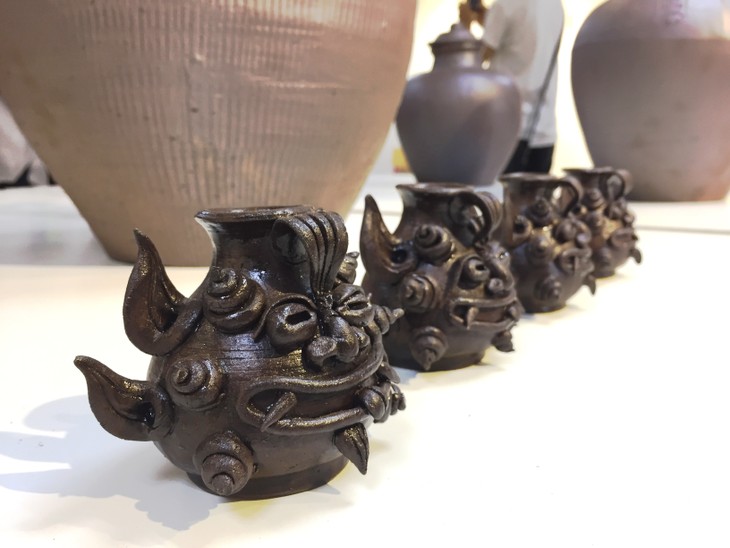 |
While preserving traditional values, Hương Canh artisans have innovated the products’ shapes, improved their techniques, and expanded the product range to meet the needs and preferences of buyers. (Photo: VOV/Dieu Ha)
|
Pottery craftsmanship in Hương Canh village is a historic cultural heritage of Vietnam. While preserving traditional values, Hương Canh artisans have restlessly innovated the products’ shapes, improved their techniques, and expanded the product range to meet the needs and preferences of buyers. Today, not only does the pottery work provide artisans with a stable income, but it has also turned Hương Canh village into a famous tourist destination where visitors can observe and participate in pottery production.